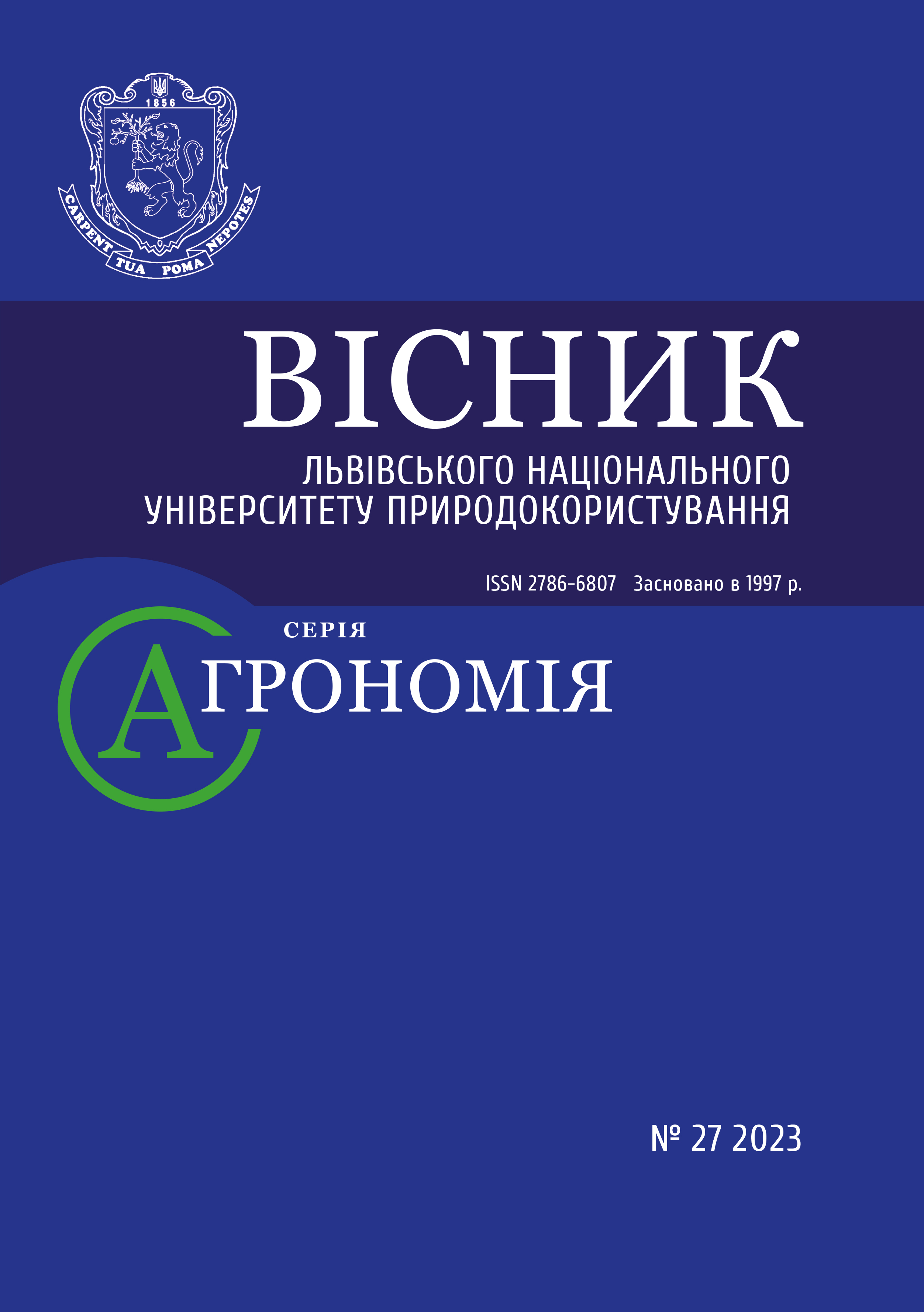ВПЛИВ СПОСОБУ ОБРОБІТКУ ҐРУНТУ НА МІКРОФЛОРУ АГРОЦЕНОЗУ КОНЮШИНИ ЛУЧНОЇ
DOI:
https://doi.org/10.31734/agronomy2023.27.068Ключові слова:
обробіток ґрунту, конюшина лучна, біологічна активність, кількість мікроорганізмів, врожайністьАнотація
Проаналізовано публікації щодо впливу способу обробітку на чисельність мікроорганізмів у ґрунті.
Досліджено, що вдосконалення способу основного обробітку сприяє покращанню агрофізичних та водних властивостей ґрунту, позитивно впливає на мікробіологічні процеси, забезпечує передумови для розширеного відтворення родючості та відновлення природного процесу ґрунтоутворення в агроценозах.
Описано результати наукових досліджень впливу способу основного обробітку ґрунту агроценозу конюшини лучної на кількість бактерій, грибів, актиноміцетів темно-сірих опідзолених ґрунтів Лісостепу Західного та врожайність сіна конюшини лучної сорту Трускавчанка. Досліджено три варіанти способу обробітку ґрунту: 1. Звичайний (контроль) – оранка плугом ПЛН-4-35 на глибину 20–22 см; 2. Чизельний – оранка плугом ПЧ-4,5 на глибину 20–22 см; 3. Ярусний – оранка плугом ПЯ-4-40 на глибину 14–16 см. Виділення основних агрономічно корисних груп мікроорганізмів з ґрунту виконано методом мікробіологічного висівання ґрунтової витяжки на тверді поживні середовища: для грибів – сусло-агар, для бактерії – м’ясо-пептонний агар (МПА), актиноміцетів – крохмально-аміачне середовище.
Встановлено, що розвиток мікроорганізмів залежить від способу основного обробітку ґрунту. Доведено позитивний вплив обробітку ґрунту на чисельність мікробіоти та врожайність сіна конюшини лучної. Комбінований спосіб основного обробітку ґрунту (оранка плугом ПЯ-4-40) створює найбільш сприятливе середовище для мікроорганізмів: бактеріальної мікробіоти (3314,1 тис.), грибів (43,7 тис.) та актиноміцетів (1565,7 тис. КУО/грам абсолютно сухого ґрунту).
Найвищий урожай сіна (110,1 ц/га) отримано за комбінованого способу основного обробітку ґрунту, що, відповідно, на 7 і 14,5 ц/га більше порівняно до контролю (звичайна оранка) і чизельного обробітку.
Посилання
Behei S. V., Shuvar I. A. Ecological farming: Textbook Lviv: New World-200, 2007. 429 p.
Demianiuk O. S., Sherstoboieva O. V., Tkach Ye. D. Functional structure of the microbial communities of deep chernozem under the influence of hydrothermal and trophic factors. Journal of microbiology. 2018. Vol. 80. No 6. P. 94–108.
Dospekhov B. A. Methodology of field experiment. Moscow: Agroproizdat, 1985. 351 p.
Dudar I., Shuvar I., Korpita H., Balkovskyi V., Shuvar B., Shuvar A., Kropyvnytskyi R. The Effect of Tillage Method on the Nutrient Regime of Soil during the Growing of Trifolium pratense. Acta Technologica Agriculturae. 2023. Vol. 26, no. 1, P. 29–35. https://doi.org/10.2478/ata-2023-0004.
Fedak L. I. Azotobacter in the agrophytocenosis of winter wheat. Agroecological journal. 2009. No 3. P. 93–94.
Gray T. R., Williams S. T. Soil microorganisms. London, 1987. 550 p.
Harwood C. S., Greenberg E. P. Mega roles of microorganisms. Science. 1999. Vol. 286, No 5442. P. 1096.
Kennedy A. C., Gewin V. L. Soil microbial diversity: Present and future considerations. Soil Sci. 1997. Vol. 162, No 9. P. 607–617.
Krasiuk L. M. Effect of the main tillage and herbicides on the biological activity of gray forest soil. Collection of scientific works of the NSC «Institute of Agriculture of the National Academy of Sciences». 2011. No 2. P. 3–9.
Oades J. M. The role of biology in the formation, stabilization and degradation of soil structure. Geoderma. 1993. No 56. P. 377–400.
Piterson A., Greman D. Biological activity of soil. International Symposium «Structure and Function of Soil Microbiota». 2005. P. 235–236.
Prus L. I. Influence of the agrotechnical measures on the biological activity of the soil, disease resistance and productivity of soybeans. Quarantine and plant protection. 2016. No 7 (238). P. 4–8.
Sendetskyi V. M. Earthworms: scientific basis of cultivation and practical aspects of application: monograph / V. M. Sendetskyi, I. A. Shuvar, N. M. Kolisnyk et al. Ivano-Frankivsk: Symphony Forte, 2015. 444 p.
Shevchenko I. P., Drach Yu. O., Yatsenko S. V. Influence of cultivation methods and fertilizers on the conditions of microbial coenosis and phytotoxic properties of the typical eroded chernozem. Herald of Agrarian Science. 2006. No. 10. P. 12–15.
Shevchenko M. V. Scientific basis of tillage systems in field crop rotations of the left-bank forest-steppe of Ukraine: diss. dr. agr. sciences: specialist 06.01.01. Kharkiv, 2015. 539 p.
Shuvar I. A. Biologization of agriculture on the way to improving the energy system “soil-fertilizer-plant”. Village owner. 2005. No 7–8. P. 23–25.
Shuvar I. A. Clover is a universal meadow culture. Scientific and practical conf. “Farming: yesterday, today, tomorrow”. Lviv, 1993. P. 121–122.
Shuvar I. A. Production and use of organic fertilizers: monograph / I. A. Shuvar, O. M. Bunchak, V. M. Sendetskyi, et al.; In general ed. I. A. Shuvar. Ivano-Frankivsk: Symphony Forte, 2015. 596 p.
Shuvar I. A., Korpita H. M. Effect of herbicides on the intensity of soil microbiological activity in spring barley and potato crops. Foothill and mountain agriculture and animal husbandry. 2016. Issue 60. P. 16–169.
Tanchyk S. P., Yamkovyi V. Yu. Impact of agrotechnical measures on soil biological activity and productivity of winter wheat in the forest-steppe of Ukraine. Scientific bulletin of NUBiP of Ukraine. 2010. No 145. P. 45–49.
Volkohon V. V., Berdnikov O. M., Tokmakova L. M., Larchenko I. V. Development of microorganisms in the rhizosphere of bare oat plants and crop yield under the action of fertilizers and biopreparation microhumin. Herald of Agrarian Science. 2017. No 2. P. 5–10.
Voss M., Sidiras N. Nodulação da soja em plantio direto em comparação com plantio convencional. Pesq. agropec. bras. Brasilia. 1985. Vol. 20. P. 775–782.
Vydynivska O. V. Microbiological conditions of southern chernozem during implementation of the no-till technology. Herald of Agrarian Science of the Black Sea Region. 2013. Issue 2. P. 99–104.


